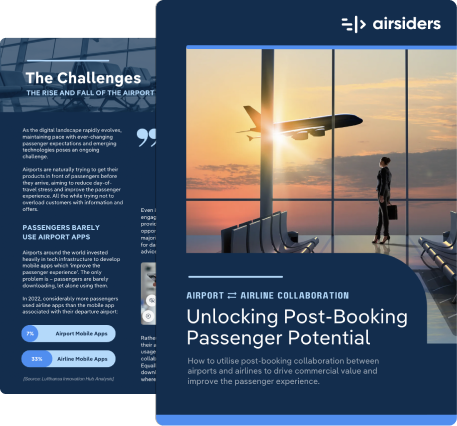The Rise of Digital Airports: Streamlining the Airport Journey for Passengers
In today's hyper-paced digital world, airports are not just transit points but (potentially) hubs of technological innovation. This article delves into how digital advancements are optimizing the airport experience, from automated check-ins to advanced security measures.
We'll explore case studies from leading airports like Singapore Changi, Amsterdam, Dubai and Rome, highlighting how these digital solutions not only enhance passenger experience but also streamline operations. Understanding these transformations is crucial for anyone in the aviation industry aiming to stay ahead in an era where efficiency, security, and passenger satisfaction are paramount.

Challenges across the Airport Journey
The airport experience, often a blend of excitement and anxiety, presents numerous challenges for passengers. These challenges, while varying in intensity, collectively impact the passenger experience and the ability for airports to improve revenues. Addressing each of the following stress indicators through digital innovation can significantly enhance the overall journey.
Let’s take a closer look at some of the key stress points for airport passengers:
Check-in and Baggage Drop:
- Long queues and uncertainty about baggage rules can cause significant stress. Passengers often worry about extra fees, baggage weight limits, and the time it takes to check in.
Security Screening:
- Security checks, while crucial for safety, can be a source of anxiety. The process can be slow, and the rules can be confusing, leading to delays and frustration.
Finding Gates and Facilities:
- Navigating a busy airport can be overwhelming, especially for first-time or infrequent flyers. Difficulty in finding gates, restrooms, or dining options adds to the stress.
Flight Delays and Cancellations:
- Uncertainty regarding flight schedules, often due to factors beyond control, can lead to anxiety and discomfort.
Boarding Process:
- The boarding process can be chaotic, with passengers often confused about boarding groups, priority access, and gate changes.

Digital Solutions to Airport Challenges
Digital technology offers innovative solutions to the challenges in airports:
- Automated Check-in and Baggage Drop: Self-service kiosks and mobile check-in apps reduce waiting times and streamline the check-in process. Smart baggage solutions, like electronic tags, ensure efficient and accurate handling.
- Advanced Security Screening: Biometric screening and advanced scanning technologies speed up security checks while maintaining high safety standards.
- Interactive Wayfinding: Digital maps and mobile apps guide passengers through the airport, providing real-time information on gates, facilities, and walking times.
- Real-Time Flight Information: Digital displays and mobile notifications keep passengers updated on flight changes, reducing uncertainty and stress.
- Efficient Boarding Processes: Digital boarding solutions, such as e-boarding passes and organized boarding notifications, simplify the boarding experience.
Implementing these digital solutions can significantly reduce the stress points in the airport journey, leading to a more pleasant and efficient experience for travelers.

Enhancing Key Stages of Airport Experience
Digital innovations significantly enhance various stages of the airport experience:
- Arrival and Check-in: Automated check-in kiosks and online check-in options offer convenience and reduce wait times. Smart baggage systems make baggage drop-off smoother and more reliable.
- Security Screening: Biometric authentication and advanced scanning technologies streamline the security process, reducing wait times and enhancing security.
- Navigating the Airport: Interactive digital signage and mobile apps provide real-time directions, gate information, and updates on amenities, helping passengers navigate the airport with ease.
- Waiting and Boarding: Digital solutions in waiting areas, like real-time flight information screens and boarding alerts on mobile apps, ensure passengers are well-informed and prepared for boarding.
- Post-Flight Services: Digital platforms can assist with post-flight needs, such as ground transportation and lost baggage tracking, improving the end-to-end journey.
By integrating these digital solutions, airports can create a seamless, stress-free experience for passengers at every stage of their journey.

Case Studies: Airports Embracing Digital Transformation
Real-World Applications of Digital Solutions in Airports
Case studies offer invaluable insights into the practical application and impact of digital solutions in airport settings. They demonstrate how innovative technologies are addressing real challenges, enhancing passenger experiences, and improving operational efficiency.
These real-world examples serve as a testament to the transformative power of digitalization in the aviation industry and provide a roadmap for future advancements.
1. Amsterdam Schiphol Airport: Enhancing Navigation and Communication
Amsterdam Schiphol Airport has taken significant strides in improving passenger experiences through digital innovation. A key development is their Passenger Experience Platform, accessible via interactive self-service kiosks and mobile devices. This platform provides crucial flight information, aids in wayfinding, and offers personal assistance, streamlining the customer support process.
The introduction of the Self-Service Unit (SSU) in 2018 further revolutionized the passenger experience. These kiosks, combining sleek design and user-friendly software, allow travelers to access a range of services, from checking flight information to video calls with airport assistants. This initiative, central to Schiphol’s service strategy, contributed to the airport winning the Skytrax Best Digital Services Award in 2023. Schiphol’s continuous focus on digital transformation, including overhauling digital channels in collaboration with Edenspiekermann, underscores its commitment to enhancing the complete passenger journey.
For more information about Schiphol's digital innovations, visit their official website here and here.
Key takeaways:
- Pivot to digital wayfinding and communication
- Collaborative digital strategy
- Future-focused digital initiatives
2. Dubai International Airport: Advancing Security with Smart Technology
Dubai International Airport, renowned for its high volume of international travel, has implemented advanced security measures to ensure both travel and health safety. The airport introduced iris scanning as a key security feature. This AI-powered technology facilitates rapid, contactless identity verification, ideal in the context of the COVID-19 pandemic.
The introduction of Smiths Detection’s HI-SCAN 6040 CTiX checkpoint scanner further underscores Dubai's commitment to enhanced security. This state-of-the-art scanner, which speeds up the security check process by eliminating the need to remove electronics and liquids from hand luggage, is an example of how the airport is integrating advanced technology to streamline operations and improve passenger experiences.
Dubai International Airport's focus on smart technology, including the integration of data with Emirates and the Dubai immigration office, is a testament to its goal of becoming a world leader in airport security and efficiency.
For a deeper look into Dubai International Airport's security technologies, you can explore further on IoT Tech Trends here and Times Aerospace here.
Key takeaways:
- Advanced security technologies
- Smarter security management
- Technological leadership and vision from management
3. Singapore Changi Airport: Pioneering Digital Wayfinding for Enhanced Passenger Experiences
Singapore Changi Airport's digital transformation exemplifies how technology can enhance airport operations and the passenger experience. A key initiative in this transformation is the DIVA (Digital, Innovation, Ventures & Analytics) program. This program has been instrumental in developing innovative digital solutions like the Safe Travel Concierge app, which provides a one-stop portal for passengers' travel needs, and the ChangiQ app, a queue management platform.
Additionally, Where2Clean, an app leveraging IoT and real-time data, helps in efficiently managing cleaning operations. These innovations contributed to Changi winning the IDC’s 2021 Future Enterprise Awards for Digital Resiliency. To learn more about Changi Airport's DIVA initiative and its impact, you can read more about it on Changi Airport's official page.
Furthermore, Changi Airport's Terminal 2 showcases state-of-the-art digital installations, including The Wonderfall, a four-story digital waterfall, and The Dreamscape, an immersive garden under a dynamic digital sky. These features not only beautify the airport but also create interactive and engaging environments for passengers.
These case studies from Changi Airport demonstrate the impactful role of digital technology in enhancing airport operations and passenger experiences.
Key Takeaways:
- Digital innovation roadmap
- Important operational impact
- Strong digital future outlook
4. Rome Airport's Wayfinding Transformation: Navigating the Future with AirportCompass
Rome Airport's collaboration with AirportCompass exemplifies how digital wayfinding solutions are revolutionizing the post-booking airport experience. This partnership, highlighted in our eBook (download on the link to learn more), showcases the strategic importance of enhancing passenger navigation for modern airports.
The Impact of Digital Wayfinding Solutions
- Enhanced Passenger Experience: AirportCompass's technology at Rome Airport created a more intuitive journey, reducing stress and confusion. This aligns with the broader aviation industry's goal of creating a digitally-coordinated environment for a seamless travel experience.
- Operational Efficiency: The implementation of digital wayfinding not only improved the passenger experience but also boosted the airport's operational efficiency. It effectively reduced congestion and optimized the use of facilities.
- Valuable Data Insights: The real-time data on passenger flow gathered through this technology enabled better resource management. This insight allows for more informed decisions regarding staffing, security, and overall airport management.
The Rome Airport case study is a prime example of how digital solutions like wayfinding technologies can address immediate passenger challenges while offering long-term operational and commercial benefits. It's a testament to the potential of strategic partnerships in the aviation industry to drive digitalization and enhance both the passenger experience and airport operations.
For more detailed insights into this case study, you can refer to the eBook. This example underlines the industry's shift towards integrating digital solutions to create more efficient, enjoyable, and streamlined travel experiences.
Key takeaways:
- Enhancing passenger navigation
- Increased operational efficiency and advanced data insights
- Long-term benefits for airport and passengers

Future of Airports: Digital Innovations on the Horizon
The future of airports lies in continuous digital innovation. Here are some of the more likely technologies to have profound change on airports over the next 5 - 10 years.
- Artificial Intelligence (AI) and Machine Learning: AI will further personalize the passenger experience, predicting individual needs and offering tailored recommendations.
- Augmented Reality (AR) for Navigation: AR technology could provide interactive, 3D navigational aids within airport apps, making wayfinding even more intuitive.
- Advanced Biometrics: Enhanced biometric systems will enable even smoother and faster processing at various stages, from check-in to boarding.
- Internet of Things (IoT) Integration: IoT can streamline operations, from baggage handling to environmental monitoring, ensuring a more efficient airport ecosystem.
- Sustainable and Smart Infrastructure: Emphasis on sustainability will drive airports to adopt smart, eco-friendly technologies.
These innovations promise to make the airport experience more efficient, enjoyable, and sustainable for passengers.
Importantly, digital transformation in airports is more than just a trend – it's reshaping how we travel. With the rollout of automated systems, biometric security, and real-time digital updates, today's airports are turning these high-tech solutions into essential tools. These innovations are key to making airport experiences smoother and more enjoyable for everyone.
Looking forward, AI, AR, and IoT integration point towards a future where airport operations are more efficient, passenger-friendly, and sustainable. As airports continue to evolve, these digital advancements will play a pivotal role in reshaping the journey from booking to boarding, ensuring a smoother, more enjoyable travel experience for all.

Want to know more? We Empower Airports through Digital Innovation
AirportCompass is dedicated to reshaping the future of air travel by integrating advanced digital solutions into the heart of airport operations. Our expertise lies in developing intuitive systems that enhance passenger experiences and streamline airport efficiency. By seamlessly connecting airlines, hubs, and travel services, we provide passengers with the tools they need for a smoother journey.
Based in Berlin, Europe's tech hub, AirportCompass brings a unique blend of innovation and practicality to the aviation industry. Our solutions are designed to transform the way airports and airlines interact with their passengers, fostering an environment of connectivity, efficiency, and satisfaction.
If you're looking to elevate your airport's passenger experience, please reach out to one of our team members. We're here to discuss how we can enhance your airport's digital footprint and transform the travel experience for passengers around the globe.

